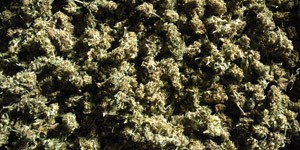By Organizing Committee of the 20th Annual Meeting of the SEIC
In the third week of November, the TWENTIETH Annual Meeting of the Sociedad Española de Investigación sobre Cannabinoides (Spanish Society for Research on Cannabinoids)(SEIC) was held in Barcelona. Over 140 researchers attended, mostly young people who are in the initial stages of their scientific career, who were given the opportunity to present their findings in a relaxed but highly scientific atmosphere as usual in SSSI meetings. The venue chosen for the occasion was the Palau Macaya, one of Barcelona's emblematic Catalan Modernist buildings, thanks to the generosity of one of the strategic sponsors of the meeting.

The meeting opened after words from the SEIC president and members of the Local Organizing Committee, who welcomed all the attendees and encouraged them to participate actively in the meeting. As in previous meetings, the inaugural lecture was given by a researcher of recognized international prestige in the field of cannabinoids. On this occasion, the plenary lecture was given by Professor Joseph Cheer (University of Maryland, USA) who explained his recent findings on the interaction of endocannabinoid and dopaminergic systems in the prediction of reward. In the first instance, Dr. Cheer summarized in a very didactic way the function of the mesolimbic dopaminergic system in the prediction of reward and in motivational processes. Specifically, he detailed experiments on the extracellular release of dopamine in the nucleus accumbens using voltammetry in animals with free movement, where we observed an increase in phasic levels of dopamine associated with drug seeking, and increased tonic associated with the reinforcing effects of drugs of abuse. He then highlighted how the CB1 rimonabant receptor antagonist decreases the increase in the phasic and tonic release of dopamine, suggesting that endocannabinoids significantly modulate dopamine transmission during behaviour motivated by conditioned stimuli. In addition, he presented his data showing that anandamide endocannabinoid specifically decreases dopaminergic activity evoked by a conditioned stimulus during reward-seeking behaviour. These experiments also suggested that anandamide acts as a competitive CB1 receptor antagonist in the presence of the other endogenous cannabinoid, 2-arachidonoylglycerol. Professor Cheer concluded his talk by pointing out that the endocannabinoid system could be used for the development of potential pharmacotherapies designed to treat motivational disorders.
After the lunch break, the scientific meeting resumed with the first of the scheduled oral sessions, which included 6 presentations on the cannabinoid system in neurodegeneration and neuroprotection. They included new data on the involvement of the CB2 receptor in Alzheimer's disease using a novel animal model and the participation of other components of the endocannabinoid system in the progression of Alzheimer's disease and in the metabolic disturbances associated with this neurodegenerative disease in another mouse model. New evidence on the neuroprotective effects of agonists for CB1/CB2 receptors in a model of frontotemporal dementia, derivatives of cannabigerol on experimental models of Parkinson's disease, and of cannabidiol on brain alterations that occur in very preterm babies using the rat as the experimental model was presented.
The second session of oral presentations focused on the involvement of the endocannabinoid system in pain and on the potential therapeutic utility of cannabinoid compounds as analgesics under certain conditions, such as newborn pain, the derivative of antineoplastic treatment or neuropathic pain, all of which were investigated in animal models. The results of a pilot study conducted in Colombia in a group of patients with chronic pain of different nature treated with various cannabis preparations were also presented.
During the second day of the meeting, a third session of oral presentations took place, a talk that addressed a hot topic in the field of cannabinoids and a round table on global trends in cannabis regulation. The third oral session focused on issues related to the marking of the cannabinoid system. In particular, studies were discussed on the signalling of cannabinoid receptors CB1 and CB2 associated with THC-induced memory alterations in murine models; with the effect of cannabis on the platelets of schizophrenic patients and with alcohol and food addictive processes. In addition, data was presented on the CBD mechanism of action on modulation of voluntary cocaine use in mice. Also, a study showing that the formation of heteromers between the CB2 receptor and of adenosine A2A in the microglia as antagonists of A2AR potentiates signalling mediated by the CB2 receptor and decrease neuroinflammation was outlined. Finally, the role of the degrading enzyme of anandamide, FAAH, in the development of breast cancer was discussed and data on the biological activity of the enantiomers of natural cannabinoids were presented.
The theme chosen this year for the hot topic was the relationship between the endocannabinoid system and adolescence. On this occasion, the paper was presented by the professor of psychobiology of the National University of Distance Education Alejandro Higuera-Matas, who has developed much of his brilliant scientific career investigating the effects of drug abuse on the adolescent brain. His talk enabled the audience in a very didactic way to update their knowledge about the influence of the social environment on the risky behaviours that usually characterize adolescents and the role that the endocannabinoid system can play in this period of brain maturation. Similarly, Dr. Higuera-Matas made an excellent review of the undeniable relationship between cannabis use and vulnerability to psychotic episodes and schizophrenia and an update of the so-called "gateway" hypothesis to the use of other drugs associated with recreational cannabis use during adolescence, which has been the subject of debate for decades. The rapporteur concluded that experimental approaches to date to resolve this issue were not optimally designed, and the validity of this hypothesis cannot be confirmed with certainty at present.
After the lunch break, the round table continued on global trends in cannabis regulation moderated by Dr. Rafael Maldonado (Pompeu Fabra University). In this session participated by Dr. Michael Evans-Brown (European Monitoring Centre for Drugs and Drug Addiction), Dr. Joseph Cheer, Sonia Moncada (Madrid city Council), and Dr. Manuel Guzmán (Complutense University). Dr. Michael Evans-Brown gave a brief presentation on the current state of regulation at European level, comparing the various regulations in the member states, reflecting on the various reasons that may push the legalization of drug abuse and commented on the main advantages of proper regulation. Dr. Joseph Cheer referred to the current pro-regulation environment in the US, which contrasts sharply with the difficulties of carrying out research projects with cannabis and its derivatives due to administrative constraints. Sonia Moncada, referring to her experience over the years in the National Drug Plan of the Ministry of Health and consumption, explained the need to increase prevention in the recreational use of cannabis derivatives, by relativizing the effectiveness of measures that advocate greater education of youth as a population at risk. Finally, Dr. Manuel Guzmán (Complutense University) advocated the urgent need to regulate the medicinal use of cannabis preparations in order to satisfy the demands of many patients whose needs are not met by another series of palliative drugs that also have numerous adverse effects.
The third and last day of the meeting began with the fourth oral presentation session in which data were presented on the effects of cannabidiol on urinary dysfunction resulting from an episode of hypoxia-ischemia, on an intraventricular haemorrhage model in newly born rats and on the treatment of a murine model of mitochondrial disease. In addition, data was presented pointing to other cannabis components such as sesquiterpene beta-caryophyllene, which showed efficacy in an animal model of Dravet syndrome. In addition, the endocannabinoid system was the target of strategies for the improvement of some aspects of the spinocerebellar ataxia type 3 by inhibition of FAAH, or of the murine model of Down syndrome by long-term blocking of CB1. Finally, the effect of multi-target compound VCE-004-8 on signalling pathways relevant to hypoxia responses was described, as were the effects of delta9-tetrahydrocannabinolic acid, cannabidiol and its combination in a murine model of diabetic nephropathy. This data revealed some adverse effects of the use of cannabidiol in this experimental model of disease.
After a short break, presentations of the awards for best publications in the field of cannabinoids were held by pre-and post-doctoral researchers in Spain during 2019. The pre-doctorate award for the publication "Cannabinoids differently modulate cortical information transmission through the sensorimotor or medial prefrontal basal ganglia circuits" in the British Journal of Pharmacology was collected by Mario Antonazzo (University of the Basque Country). The award of postdoctoral training given to the publication "Therapeutic targeting of HER2-CB2R heteromers in HER2-positive breast cancer" in the Proceedings of the National Academy of Sciences of the USA was awarded to Martha Seijo-Vila. The meeting closed with awards for the best speeches and speakers and words of farewell from the newly elected president of the SEIC, Dr. Pedro Grandes (University of the Basque Country).


